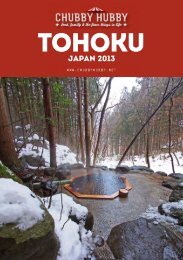You also want an ePaper? Increase the reach of your titles
YUMPU automatically turns print PDFs into web optimized ePapers that Google loves.
<strong>AUGUST</strong><strong>2013</strong>CULTURAL E-MAGAZINE© Tomoyuki Kambe
UPCOMING EVENTSAugust <strong>2013</strong><strong>AUGUST</strong> EVENTS IN JCC28 August <strong>2013</strong> Artist Talk: Introduction to "BUNRAKU"31 August <strong>2013</strong> JCC Cinema 21 : “Departures”SNEAK PREVIEW OF EVENTS IN SEPTEMBER <strong>2013</strong>2 September <strong>2013</strong> "Thinking about Ikebana" Ikenobo Lecture & WorkshopRELATED EVENTS17 May -17 November <strong>2013</strong> Kindred Spirits: Dr. Sun Yat Sen, Singapore and <strong>Japan</strong>8 & 9 November <strong>2013</strong> 3 Titans <strong>of</strong> Theatre - MUSASHI by Yukio NinagawaNOTICE40th Year <strong>of</strong> ASEAN-<strong>Japan</strong> Friendship and CooperationThe <strong>Japan</strong> Foundation Program Guidelines for Fiscal <strong>2013</strong>-201440 th YEAR OF ASEAN-JAPANFRIENDSHIP AND COOPERATIONFurther information and updates about JCC events can be found on the JCC website and Facebook.1 | P a g e
C O N T E N T SOVERVIEW OF JCC’S PAST EVENTS IN JULY <strong>2013</strong>3 INNOCENT WORLD ART EXHIBITION4 INNOCENT WORLD WORKSHOP FOR CHILDREN5 MR KAMBE MASTERCLASS AT SOTA6 MR KAMBE LECTURE AT SOTA7 JAPANESE SPEECH CONTESTJAPANESE CULTURE FACT OF THE MONTH8 BON HOLIDAYS2 | P a g e© Tomoyuki Kambe
1 OVERVIEWIn July, <strong>Japan</strong> Creative Centre welcomed the talented Artist Mr. Tomoyuki Kambefrom <strong>Japan</strong> to hold his first solo exhibition in Singapore. Whilst in town, Mr Kambealso presented a series <strong>of</strong> events including a Workshop for children andMasterclass based on traditional <strong>Japan</strong>ese painting. A special lecture was alsopresented to introduce the history <strong>of</strong> traditional <strong>Japan</strong>ese art and the use <strong>of</strong>traditional techniques in modern art.1. 1 INNOCENT WORLD ART EXHIBITIONTomoyuki Kambe, an emerging artist from Gifu Prefecture <strong>of</strong> <strong>Japan</strong>, held his solo exhibitionentitled “Innocent World” at the <strong>Japan</strong> Creative Centre from 20 July to 3 August. This exhibitionwas one <strong>of</strong> JCC’s highlights <strong>of</strong> the year. Mr Kambe works with traditional materials such asnatural rocks and minerals from his hometown to create the necessary pigment for painting. Allhis materials used to create the artworks are natural and organic, with the utmost respect andpreservation for nature in mind.His paintings reflect his passion for natureand the microscopic living elements whichhe believes makes up the essence <strong>of</strong> thisworld. He believes that every small detailadds up to the whole big picture.The Opening Ceremony <strong>of</strong> “InnocentWorld” was held as a closed door event on19 July <strong>2013</strong> at the <strong>Japan</strong> Creative Centre.Mr Tomoyuki saying a few wordsAttendance was a full house with thepresence <strong>of</strong> ambassadors, high commissioners and foreign diplomatic <strong>of</strong>ficers. Art Galleryowners and managers as well as Singapore government <strong>of</strong>ficials were also present tocongratulate the artist. During this event, Ambassador <strong>of</strong> <strong>Japan</strong>, His Excellency Yoichi Suzukipresented the Exhibition Opening Remarks followed by a short but heartfelt introduction by theartist Tomoyuki Kambe.3 | P a g e
1.3 MR KAMBE MASTERCLASS AT SOTADuring his visit to Singapore, Mr Tomoyuki Kambe met up with future budding artists from theVisual Arts Faculty <strong>of</strong> School <strong>of</strong> The Arts (SOTA) on 23th July.SOTA students were shown some traditionalmaterials used in <strong>Japan</strong>ese paintingStudents fascinated at the gold foil used in the worksThe students and teachers were thrilled to have him in their classroom and quickly warmed upto his gentle demeanor.During the intense two and a half hour session, MrKambe demonstrated the <strong>Japan</strong>ese traditional form<strong>of</strong> art using gold and silver foil as well as naturalminerals and pigments to embellish the work. Thestudents proceeded to try their hand at the<strong>Japan</strong>ese technique <strong>of</strong> painting, and were taken inby its difference to western and modern art forms.At the end <strong>of</strong> the session, Mr Kambe himself wasamazed at the finished pieces by the students whoStudents working hard during the Masterclassalso expressed much enjoyment from theMasterclass. The students were all smiles whenthe tough technique <strong>of</strong> applying the foils,stenciling and ironing were over and wereadmiring their own efforts as well as that <strong>of</strong>classmates. The teachers and students hadexpressed much inspiration and revelation fromthe Masterclass.An amazing piece completed by a student5 | P a g e
1.4 MR KAMBE LECTURE AT SOTAOn 25 th July, Mr Kambe presented a lecture at School <strong>of</strong> The Arts (SOTA). There was anincredible turnout <strong>of</strong> students all awaiting to meet with the artist.During the lecture, Mr Kambe began with a shortintroduction on <strong>Japan</strong>ese traditional paintings and<strong>Japan</strong>ese Fine Arts. He also touched uponprominent works by notable artists in <strong>Japan</strong>’shistory with a slideshow <strong>of</strong> paintings. Mr Kambewent on to share his inspiration to paint nature andhis immense adoration for the natural worldespecially in the microscopic elements that thriveunnoticed each day. One <strong>of</strong> these unnoticed butfascinating moments for Mr Kambe was the largeMr Kambe at SOTA to present a lectureripples that a little frog had formed from leaping intoa small lake, which inspired him in one <strong>of</strong> his works. His paintings usually involve tiny wildlifeand he expressed the similarity <strong>of</strong> their survival in nature to that <strong>of</strong> humans in the world. Hefrequently feeds and spends quite moments with these little creatures and appreciates theiressence in nature.Students from SOTA during the lecture byMr KambeMr Kambe thus shared the reasons for usingnatural elements, minerals and pigments in hisartwork. He humbly showed the students hiscollection <strong>of</strong> brushes and natural stones fromwhich he makes his own paint as well as naturalglue. He also presented a very special slideshow<strong>of</strong> his completed works at which the studentswere fascinated.After the lecture, the students gathered aroundMr Kambe to have a feel <strong>of</strong> the natural rocksand minerals. Most <strong>of</strong> the students who attendedthe lecture also took the opportunity to get Mr Kambe’s autograph in their sketchbooks, whilstsome took individual photos with the artist. Some stayed back to ask Mr Kambe questions andgain some advice on their projects.The lecture was indeed successful, with the teachers and students from SOTA conveying theirappreciation to the artist.6 | P a g e
1.5 JAPANESE SPEECH CONTESTThe <strong>Japan</strong>ese Speech Contest <strong>2013</strong> was held on21 July at the <strong>Japan</strong>ese Association Singapore.The contest was co-organized by the <strong>Japan</strong>eseAssociation Singapore, the <strong>Japan</strong>ese CulturalSociety, the <strong>Japan</strong>ese Chamber <strong>of</strong> Commerce &Industry, the <strong>Japan</strong>ese University GraduatesAssociation <strong>of</strong> Singapore and the <strong>Embassy</strong> <strong>of</strong><strong>Japan</strong> in Singapore.This annual competition comprised <strong>of</strong> fourcategories; namely, the Secondary SchoolGroup Photo <strong>of</strong> the final contestants with thecompetition organizers and judgesDivision, the Junior College Division, the Tertiary School Division and the Open Division. Out <strong>of</strong>the many applications received this year, the competition was tight amongst the top six finalistsfrom each category.Ambassador <strong>of</strong> <strong>Japan</strong> to Singapore, HisExcellency Yoichi Suzuki with the winnersfrom each category.The finalists presented on topics <strong>of</strong> their freechoices such as Hyakunin Isshu (<strong>Japan</strong>esetraditional card game), <strong>Japan</strong>ese animationand idle. They shared with audience theuniquely Singaporean point <strong>of</strong> view, and itwas very interesting for the <strong>Japan</strong>esepeople who had attended the event. Thelevel <strong>of</strong> competition had been so stiff thatthe judges themselves had some difficulty inranking and selecting the winners.Some <strong>of</strong> the top winners had been awarded attractive prizes including home-stay tour inShizuoka or Hokkaido. Congratulations to the winners!7 | P a g e
2 JAPANESE CULTURAL FACT OF THEMONTH2.1 BON HOLIDAYSThe Bon Festival 1 is held to pray for the repose <strong>of</strong>the souls <strong>of</strong> one's ancestors. It's one <strong>of</strong> the biggesttraditional events during the year, along with NewYear's. It's sometimes called o-bon or urabon. In thepast, it was held in the middle <strong>of</strong> the seventh monthon <strong>Japan</strong>'s traditional calendar. Some regionstherefore celebrate it in mid-July, although the olddate is closer to mid-August.People send lanterns down rivers to "see <strong>of</strong>f"the spirits <strong>of</strong> their relatives. (TokyoMetropolitan Government)Deceased family members are believed to revisit the homestead during Bon to be reunited withtheir family. To guide the souls back, a small bonfire is lit outside the house. This is called themukae-bi, or welcoming flame. The house is cleaned and dusted, and fruits and vegetables are<strong>of</strong>fered at family altars. When Bon ends, the spirits are sent <strong>of</strong>f with another bonfire, calledokuri-bi. Some regions release small lanterns down rivers or into the sea as part <strong>of</strong> the okuri-biritual.Many Buddhist temples hold a service calledurabon'e during this time, and so a lot <strong>of</strong> peoplethink Bon is a Buddhist tradition. But historiansnow think that indigenous <strong>Japan</strong>ese practicescombined with Buddhist concepts to give shapeto the Bon customs observed today.Everyone looks forward to Bon odori in summertime.(Tokyo Metropolitan Government)The biggest event <strong>of</strong> the Bon season is the Bonodori (dance), which is held throughout <strong>Japan</strong>.One <strong>of</strong> the most famous is the Awa odori <strong>of</strong>Tokushima. People usually go to the neighborhood park or shrine in yukata (summer kimono)and dance in a circle to recorded music.Mid-August comes during summer vacation for elementary and middle school students. A lot <strong>of</strong>1 http://web-japan.org/kidsweb/explore/calendar/august/bon.html8 | P a g e
companies, too, now <strong>of</strong>fer their workers time <strong>of</strong>f by closing their factories and <strong>of</strong>fices duringBon. Urban residents take advantage <strong>of</strong> the holidays to return to their hometowns andparticipate in Bon events.For the kids, the Bon break is a chance to visit their grandparents and meet other relatives. Thebeginning and end <strong>of</strong> the Bon holidays are marked long traffic jams <strong>of</strong> people leaving andreturning to their urban residences. Airports and major train stations become jam packed withtravelers, and expressways leading in and out <strong>of</strong> big cities get clogged up for 30 kilometers (18.5miles) or more. Shinkansen (bullet trains) and other long-distance trains <strong>of</strong>ten run at 180% <strong>of</strong>capacity.9 | P a g e
Any comments for JCCe-magazine?We would love to hear them!So please do send in your suggestions and thoughts tojcc@sn.m<strong>of</strong>a.go.jp.10 | P a g e







